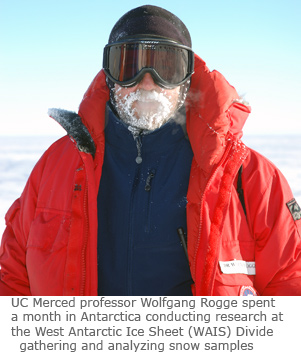

UC Merced’s
Wolfgang Roggehas been to the bottom of the Earth and back in the name of science.
Rogge, an associate professor in the
School of Engineeringand air pollution specialist, recently returned from Antarctica where he and UC Merced
doctoralstudent Sylvain Masclin spent more than two months.
Rogge, together with his co-investigators,
Sierra Nevada Research InstituteDirector
Roger Balesand Markus Frey of the British Antarctic Society, are part of a group of scientists involved in the West Antarctic Ice Sheet (WAIS) Divide Ice Core Project.
Funded by the National Science Foundation, the WAIS Project’s main objectives include:
- Developing a detailed record of greenhouse gases for the last 100,000 years
- Determining whether global climate changes that have occurred during that time period were prompted by changes in the northern or southern hemisphere
- Investigating the past and future stability of the West Antarctic Ice Sheet
For the UC Merced-based
researchproject, Rogge and Masclin are interested in the current and past oxidative state of the Antarctic atmosphere controlled mainly by atmospheric radicals, of which the hydrogen radical is the most important. A major driving force for the oxidative power of the atmosphere during the Antarctic summer is the photochemistry occurring in the atmosphere and also in the top snow layer.
The hydroxyl radical and other ambient radicals, Rogge explained, are extremely reactive and are able to eventually break down most of the pollutants found in the atmosphere, and therefore extremely important, especially when we pollute the air massively with pollutants from many sources, Rogge explained.
In Antarctica, he and Masclin were measuring during this first field season several ambient trace gases such as formaldehyde, organic and hydrogen peroxides, ozone, and others. They also took snow samples for chemical analysis.
The idea is that if we can figure out the transfer of key components involved in photochemistry in the atmosphere to the snow and ultimately into the ice, we may be able to determine the past oxidative state of the Antarctic atmosphere by drilling ice cores and analyzing them, Rogge said. If successful, we could go back in time and see what the oxidative state of the atmosphere has been in the Antarctic and if it changed in the past to investigate the possible causes of this change.
This trip was Rogge’s first to Antarctica and getting there was an adventure in itself. He and Masclin arrived at the McMurdo Station on Ross Island, an Antarctic research center on Nov. 11. Before making the trek to WAIS Divide, the duo had to complete some basic training to help them endure the harsh, cold conditions. During their time at WAIS-Divide, the temperature got as cold as -30 degrees Fahrenheit.
We were sleeping in tents and learning what not to do, he said.
One of the first lessons: Dress in layers. We were wearing so many layers of clothes that it actually did not feel so cold, he said.
They also learned to flag their path out in the no man’s land with flagpoles that helped prevent them from getting lost when weather conditions changed suddenly and visibility dropped drastically. Goggles were another necessity.
The sun is just intense down there, he said. There was daylight 24 hours.






